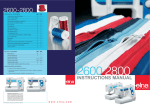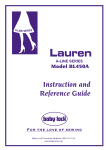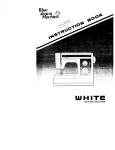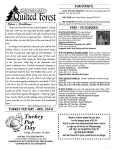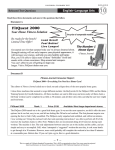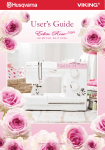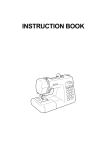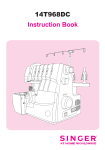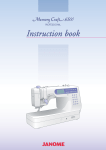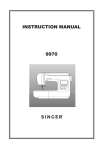Download Viking Emerald 183 Owner`s manual
Transcript
Emerald 183
Almost The Manual
Last Modified
Monday, October 19, 2009 at 10:09:50 PM
Document Revision: 89
Table of Contents
Table of Contents........................................................................................................................i
1. Introduction...........................................................................................................................5
2. SAFETY INSTRUCTIONS..................................................................................................1
2.1. WARNING...................................................................................................................1
2.2. Machine Overview........................................................................................................2
3. Preparing to sew....................................................................................................................7
3.1. Unpacking ....................................................................................................................7
3.2. Packing away after sewing ...........................................................................................7
3.3. Accessory box ..............................................................................................................8
3.4. Removing the accessory box / Using the free arm .......................................................8
3.5. Connecting the foot control .........................................................................................8
3.6. Connect the power supply.............................................................................................9
3.7. For USA and Canada....................................................................................................9
3.8. Sewing Guide Reference Chart.....................................................................................9
3.9. Lower the feed teeth ...................................................................................................11
3.10. Changing the presser foot..........................................................................................11
3.11. Changing the needle .................................................................................................11
3.12. Needles......................................................................................................................12
A Universal Needles ...................................................................................................12
B Stretch Needles ........................................................................................................12
C jeans Needles Sizes 90 .............................................................................................12
3.13. Spool pins..................................................................................................................13
3.13.1. Horizontal Position ...........................................................................................13
3.13.2. Vertical Position ...............................................................................................13
3.14. Threading the upper thread ......................................................................................14
3.15. Cutting the thread .....................................................................................................14
3.16. Needle threader ........................................................................................................15
3.17. Threading for twin needle........................................................................................16
3.18. Winding the bobbin using the vertical spool pin .....................................................16
3.19. Placing the bobbin in the machine ...........................................................................17
3.20. Presser foot lifter ......................................................................................................17
3.21. Correct and incorrect thread tension ........................................................................17
4. Operating the machine........................................................................................................19
4.1. Function buttons on the machine................................................................................19
4.1.1. Speed control slide .............................................................................................19
4.1.2. Foot control.........................................................................................................19
4.1.3. Needle Stop Up Down (A) .................................................................................19
4.1.4. Stop (B) ..............................................................................................................19
4.1.5. Fix (C) ................................................................................................................19
4.1.6. Reverse (D)..........................................................................................................20
4.1.7. Presser foot pressure dial.....................................................................................20
i
4.1.8. Stitch balance (A) ...............................................................................................20
4.2. Function buttons..........................................................................................................21
4.2.1. Direct Stitch Selection buttons (A) .....................................................................21
4.2.2. Stitch Width (B) .................................................................................................21
4.2.3. Stitch Length (C).................................................................................................21
4.2.4. Menu Selection button (D) .................................................................................21
4.2.5. Memory button (A) .............................................................................................22
4.2.6. Mirror Side to Side (B)........................................................................................22
4.2.7. Stitch elongation button (C) ...............................................................................22
4.2.8. Edit button (A) ....................................................................................................23
4.2.9. Clear button (B) ..................................................................................................23
4.3. Buzzer sound ..............................................................................................................23
4.4. Display icons...............................................................................................................24
4.4.1. Display icons:Alphabet ......................................................................................24
4.4.2. Display icon: Elongation ....................................................................................25
4.4.3. Display icon: Memory.........................................................................................25
4.5. Warning messages.......................................................................................................26
4.5.1. Presser foot not lowered .....................................................................................26
4.5.2. Main motor blocked............................................................................................26
4.5.3. Buttonhole lever not lowered..............................................................................26
4.5.4. Buttonhole lever not lifted ..................................................................................26
4.5.5. Bobbin winding ..................................................................................................26
4.6. Programming ..............................................................................................................27
4.7. Create a combination ..................................................................................................27
4.8. Adding stitches or letters in a sequence......................................................................28
4.9. Editing Stitches/Letters...............................................................................................28
4.10. Removing Stitches/Letters .......................................................................................28
4.11. Opening and sewing a stitch memory ......................................................................28
4.12. Stitch elongation........................................................................................................29
5. Basic sewing techniques.....................................................................................................30
5.1. Seam............................................................................................................................30
5.2. Edge/Quilting Guide ..................................................................................................30
5.3. Overcast ......................................................................................................................31
5.4. Seam and overcast ......................................................................................................31
5.5. Darning and mending .................................................................................................32
5.6. Sewing hems in heavy fabric .....................................................................................32
5.7. Blind hem ...................................................................................................................33
5.8. Sewing buttonholes ....................................................................................................34
5.9. Buttonhole Slider Foot C ...........................................................................................34
5.10. A Corded Buttonhole (Stretch fabrics) ....................................................................35
5.11. Sewing on buttons ....................................................................................................35
ii
5.12. Sewing zippers .........................................................................................................36
5.12.1. Center Zipper ....................................................................................................36
5.13. Gathering...................................................................................................................37
6. Taking care of the machine.................................................................................................38
6.1. Changing the light bulb ..............................................................................................38
6.2. Care of the machine ...................................................................................................38
6.3. Cleaning......................................................................................................................38
6.3.1. Clean the Bobbin Area........................................................................................38
6.3.2. Cleaning Under the Bobbin.................................................................................39
6.4. Trouble shooting.........................................................................................................41
Any time you experience a problem when sewing:........................................................41
Fabric Puckers................................................................................................................41
Skipped Stitches.............................................................................................................41
Needle Breaks.................................................................................................................41
Poor Tension...................................................................................................................41
Upper Thread Breaks......................................................................................................42
Fabric Does Not Move...................................................................................................42
Bobbin Thread Breaks....................................................................................................42
Bobbin Winds Irregularly...............................................................................................42
Wrong Stitch, Irregular or Narrow Stitches...................................................................42
Machine Sews Slowly....................................................................................................42
Machine Will Not Sew...................................................................................................42
Main Motor Blocked......................................................................................................43
Service machine regularly..............................................................................................43
NonOriginal Parts and Accessories...............................................................................43
Appendix A. Stitches...............................................................................................................45
Appendix B. Alphabetical Index..............................................................................................49
Appendix C. Glossary..............................................................................................................51
Last Page..................................................................................................................................53
iii
1. Introduction
This document exists the following reasons:
1. The manufacturer does not offer the manual for the Emerald 183 sewing machine as a
PDF download.
2. If you lose the manual, an inexperienced person such as myself is not able to use the
sewing machine.
3. I lost my manual, three times. I have always found it, but it frequently disappears.
The good news is that I captured most of what is contained in the original manual. The bad
part is that I have likely introduced numerous errors, which will cause you to injure yourself,
burn down the house, and generally destroy humanity as we know it. As such, the use of any
material contained in this document is at your own risk.
This document contains significant material from the owner's manual for the Emerald 183.
As such, I cannot lay claim to the majority of the contained material.
I generated the document using OpenOffice.org, and then I generate a PDF for the general
population. If you desire an original source document, just let me know.
5
2. SAFETY INSTRUCTIONS
The Viking Emerald 183 is household sewing machine designed to comply with IEC/EN 60335-2-28
and ULI 594. When using an electrical appliance, basic safety precautions should always be
followed, including reading all of the instructions before use. I like to say, do not be an idiot.
2.1. WARNING
To reduce the risk of burns, fire, electric shock, or injury to persons:
•
Never leave the machine plugged in and unattended.
•
Always unplug the machine after using, before cleaning, and before replacing the lamp.
•
Replace the bulb with same type rated 5 Watt.
•
Do not use as a toy; close attention is necessary when used by or near children and infirm
persons.
•
Use only as intended as described in the manual. Use only attachments recommended by the
manufacturer as contained in the manual.
•
Never operate with a damaged cord or plug, if not working properly; if it has been dropped,
damaged, or dropped into water. Return the machine to the nearest authorized dealer or
service center for examination, repair, or adjustment.
•
Never operate with any air openings blocked. Keep ventilation openings for the sewing
machine and foot controller free from lint, dust, and loose cloth.
•
Keep fingers away from all moving parts. Special care is required around the needle.
•
Always use the proper needle plate. The wrong plate can cause the needle to break.
•
Do not use bent needles.
•
Do not pull or push fabric while stitching, it may deflect and break the needle.
•
Switch the machine off ("O") when making adjustment near the needle, such as threading
needle, changing needle, threading bobbin, changing presser foot, etc.
•
Always unplug when removing covers, lubricating, or when making any other user servicing
adjustments.
•
Never drop or insert any object into any opening.
•
Do not use outdoors.
•
Do not operate where aerosol (spray) products are being used or where oxygen is being
administrated.
•
To disconnect, turn all controls to the off ("O") position, then unplug.
•
Do not unplug by pulling on cord. To unplug, grasp the plug, not the cord.
•
The sound pressure level under normal operating conditions is ≤75dB(A).
SAVE THESE INSTRUCTIONS
1
2.2. Machine Overview
1. Bobbin thread tension disks.
13. Presser foot pressure dial.
2. Lid.
14. Thread take-up lever.
3. Information display.
15. Presser var and presser foot ankle.
4. Hand-wheel.
16. Presser foot.
5. Active menu indicator.
17. Needle.
6. Function panel.
18. Needle clamp screw.
7. Main power switch, connection to
power supply, and foot control
connection.
19. Presser foot lever.
20. Reverse button.
21. Drop feed lever.
8. Accessory box.
22. Needle up / down.
9. Bobbin cover.
23. STOP button.
10. Needle plate.
24. FIX button.
11. Light.
25. Speed control slide.
12. Thread cutter.
26. Thread tension disks.
2
Table 1. Accessories included with sewing machine.
Image
Name
Description
Utility Foot A Attached on delivery, this foot is used mainly
for straight and zigzag stitching with a stitch
length longer than 1.0 mm.
Presser Foot B Tunnel on the bottom of the foot is designed to
feed smoothly over zigzag and satin stitches
with less than 1.0 mm stitch length, and other
utility and decorative stitches.
Buttonhole
Slider Foot C
Foot has space in back to set the buttonhole
size. The machine will sew a buttonhole to fit
that button size.
Blind Hem
Foot D
Use for blind hem stitches. The inner edge of
this foot guides the fabric. The right toe of the
foot is designed to ride along the hem edge.
Zipper Foot E
(or cording).
Foot may be snapped on the right or left side of
the needle so that it is easy to sew close to both
sides of a zipper. Move needle position right or
left to sew closer to zipper teeth or for covering
large cording.
Non Stick
Glide Foot H
This foot has a smooth coating for sewing foam,
vinyl, plastic, or leather to minimize the risk
that these materials will stick to the foot.
Edging Foot J
Used for overcasting and seam / overcasting think stitches with width of 5.0 and 5.5 mm.
Stitches form over the ping, which prevents
puckering at the edge of the fabric.
Quilter's ¼"
Used when piecing quilt blocks. The foot has
Piecing Foot P seam guide marks at ¼" (6 mm) and ⅛" (3 mm).
Transparent
Foot B
Used for decorative sewing, the underside is the
same as presser foot B.
Gathering Foot Used for gathering fabric or to gather and attach
a ruffle in one step. The foot is suitable for light
to medium weight fabrics.
3
Image
Name
Description
Screwdriver
Use to remove the needle and other similar
tasks.
Brush
Clean lint
Felt pad
Seam Ripper
Clearance plate Used to keep buttons off the fabric while
/ Button reed sewing so that the button can move.
Bobbins
Needle pack
Large Spool
Cap
Small Spool
Cap
Used to hold thread in place.
Edge / Quilting
guide
Light bulb
remover
4
Image
Name
Description
Carrying case
Accessory box The accessory box is attached to the machine on
delivery.
Foot control and power cord.
5
3. Preparing to sew
3.1. Unpacking
1. Place the machine on a sturdy, flat surface, remove the packaging and lift off the cover.
2. The machine is delivered with an accessory bag, a main cord and a foot control cord.
3. Wipe the machine, particularly around the needle and needle plate to remove any soil before
sewing.
3.2. Packing away after sewing
1. Press the power switch to turn off the machine.
2. Unplug the cord from the wall socket and then from the machine.
3. Wind main cord around your hand and place the cord in the space in the carrying case (A).
4. Unplug the foot control cord from the machine. Wind the foot control cord around your hand
and place it in the space of the foot control (B).
5. Check to ensure that all accessories are in the accessory box. Slide the box on to the machine.
6. Press the foot control together and place it in the foot control space in your carrying case (C
and D).
Figure 1. Packing away after sewing.
7
3.3. Accessory box
In the accessory box there is a special tray for presser feet and bobbins plus a
space for other accessories. Store the presser feet and the bobbins in the tray
so they are always easily accessible.
3.4. Removing the accessory box / Using the free arm
Keep the accessory box on the machine to provide a larger flat work surface.
Slide the accessory box to the left when you wish to remove it and use the
free arm. To facilitate sewing trouser legs and sleeve seems, use the
free arm. To replace the Accessory Box, slide it tight onto the
machine until it is in place.
3.5. Connecting the foot control
Among the accessories you will find the foot control cord and the main power cord. Connecting the
foot control cord to the foot control is only necessary the very first time you are going to use the
machine.
1. Take out the foot control cord. Turn the foot control over. Connect the cord to the socket
inside the space of the foot control.
2. Push firmly to make sure it is properly connected.
3. Lay the cord into the slot on the underside of the foot control.
Figure 2. Foot controller.
8
3.6. Connect the power supply
On the underside of the machine you will End information about the
power supply voltage (V) and the frequency (Hz).
Before plugging in the foot control, check to ensure that it is of type
"FR4" (see underside of foot control).
1. Connect the foot control cord to the front socket on the bottom
right side of the machine (A).
2. Connect the power cord to the rear socket on the bottom right
side of the machine (B).
3. When you press the power switch to ON (C), both the
machine and the light are switched on.
3.7. For USA and Canada
This sewing machine has a polarized plug (one blade wider than the
other). To reduce the risk of electric shock, this plug is intended to fit in a polarized outlet only one
way. If the plug does not fit fully in the outlet, reverse the plug. If it still does not fit, contact a
qualified electrician to install the proper outlet. Do not modify the plug in any way
3.8. Sewing Guide Reference Chart
Consult the Sewing Guide Reference Chart for the fast easy way to select the best stitch, stitch
length, stitch width, thread tension, presser foot, and presser foot pressure for your sewing technique
and fabric.
9
Table 2: Look in the column for your fabric type.
Woven Fabrics: for stable fabrics that have no stretch. Usually woven.
Stretch Fabrics: for fabrics that have stretch. Usually knit.
Leather/Vinyl: for suede, real leather, and for artificial leather and suede.
Table 3: Select the stitch for the technique you want to sew:
SEAM: sews two pieces of fabric together.
OVERCAST: overcast fabric edges to prevent them from fraying and to
help them lay flat.
SEAM/OVERCAST: sews the seam and overcasts the edge all at one
time.
BASTE: a temporary stitching for fitting garments, gathering and marking.
Use maximum stitch length.
Note: Basting will leave permanent holes in leather and vinyl.
BLIND HEM: creates an invisible hem on garments. Is not recommended
for light weight fabric or for leather/ vinyl.
HEM: sews the best visible or top stitch hem for your fabric type and
weight.
BUTTONHOLE: sews the best buttonhole possible for your fabric.
1.
2.
3.
4.
5.
6.
7.
8.
Figure 3. Stitch guide key.
10
Fabric
Presser foot pressure
Sewing technique
Stitch
Presser foot
Thread tension
Stitch length
Stitch width
3.9. Lower the feed teeth
You must remove the accessory box to lower the feed teeth.
The feed teeth lever is located on the back of the machine at
the base of the free-arm. Slide the lever to the right to lower
the feed teeth. The feed teeth are raised when you move the
lever (A) to the left. The feed teeth will come up when you
begin to sew or turn the hand-wheel towards you. The feed
teeth should be lowered when sewing on buttons.
3.10. Changing the presser foot
Turn of the main switch.
1. Make sure the needle is in the highest position; Pull the presser foot towards you.
2. Line up the cross pin on the foot with the gap in the presser foot ankle. Press back until the
foot snaps into place.
Figure 4. Changing the presser foot.
3.11. Changing the needle
Turn of the main switch.
1. Loosen the screw in the needle clamp
(B) with the screwdriver.
2. Remove the needle.
3. Push the new needle upwards with the flat side away
from you until it will go no further.
4. Use the screwdriver to tighten the screw (B).
11
3.12. Needles
The sewing machine needle plays an important role in successful
sewing. To ensure you will get a quality needle, we recommend
needle system 130/705H. The needle package included with your
machine contains needles of the most popular sizes for sewing on
woven and stretch fabrics.
A - Universal Needles
For all woven fabrics, The slightly rounded needle point is designed
to penetrate between the threads of the fabric so the fabric will not
be damaged.
B - Stretch Needles
For both knit and stretch fabrics. The stretch needle is marked
yellow and has a rounded point to prevent damaging knit fabric.
C - jeans Needles Sizes 90
These needles are used for sewing woven heavy fabrics, for
example denim and canvas fabric. The jeans needle is marked blue
and has an extremely sharp point to facilitate the penetration of the
fabric.
Note: Change the needle often. Always use a straight needle with a
sharp point (C). A damaged needle (D) can cause skipped stitches,
breakage of needles or snapping of thread. A damaged needle can
also damage the needle plate.
12
3.13. Spool pins
The Emerald 183 has two spool pins, a main spool pin
and an auxiliary spool pin. The main horizontal spool pin
(A) is used For sewing with normal threads. The auxiliary
vertical spool pin can be used for large spools of thread or
specialty threads. Also use the vertical spool pin for
bobbin winding.
3.13.1. Horizontal Position
1. Place the small spool cap on the spool pin.
2. Place the thread spool on the spool pin so the
thread reels over the top, counter clockwise.
3. Slide on a spool cap slightly larger than the spool.
Note: There are two spool caps on the spool pin. For narrow thread spools, the small holder is placed
in front of the spool. For large thread spools, the large holder is placed in front of the spool.
4. Press the flat side of the spool cap Firmly against the spool. There should be no space
between spool cap and thread spool so the threads reels off Freely.
3.13.2. Vertical Position
The vertical spool pin is used when winding a bobbin
from a second spool of thread or for a second spool when
sewing with a twin needle. It can also be used when you
are sewing with specialty threads.
1. Pull the spool pin out towards you and turn to the
vertical position.
2. Slide on the large spool cap and place a felt pad
under the thread spool. This is to prevent the
thread from reeling off too fast.
13
3.14. Threading the upper thread
Make sure the presser foot is raised and the needle is in the up position.
Turn off the main switch.
1. Pull up the spool pin. Place a spool cap and then the thread
on the spool pin. Place the second spool cap on the spool
pin (A). Push the spool pin back in.
2. Bring the thread in the direction of the arrow under the
thread guide (B) so that the thread snaps into place. Then
bring the thread under the second thread guide (C).
3. Bring the thread down between the thread tension discs D.
4. Continue threading by drawing the thread up into the slot
on the take-up lever E from the right to the left.
5. There are two thread guides close to the needle: F and G.
Insert the thread into the two thread guides.
6. The needle is threaded from front to back. The white on the
presser foot ankle makes it easy to see the eye of the needle.
See needle threader instructions on the next page.
7. Place thread under the presser foot and into the thread
cutter where it is cut.
3.15. Cutting the thread
When you are finished sewing, you can cut the thread by raising
the presser foot and drawing the threads to the left side of the
machine and cut them using the thread cutter.
14
3.16. Needle threader
The needle must be in the up position to
use the built-in needle threader. We also
recommend lowering the presser foot.
1. Use the handle to pull the needle
threader down, catching the thread
under the guide (A).
2. Push the needle threader all the
way down until the metal flanges
cover the needle. A small hook will
pass through the needle eye (B).
3. Place the thread under the flanges
in front of the needle, so that the
thread catches into the small hook.
4. Let the needle threader gently
swing back. The hook pulls the
thread through the needle eye and
forms a loop behind the needle. Pull
the thread loop out behind the
needle.
5. Place the thread under the presser
foot and cut the thread.
Note: The needle threader is designed to be
used for size 70- 120 needles. You cannot
use the needle threader for size 60 needles
or smaller, the wing needle, twin needle, or
triple needle. There are also some optional
accessories that require manual threading of
the needle.
When threading the needle, manually make
sure that the needle is threaded from front to
back. The white presser foot ankle makes it
easy to see the eye of the needle.
15
3.17. Threading for twin needle
Turn off the main switch.
1. Insert a twin needle.
2. Thread the machine as explained on page 15 and thread
the left needle.
3. Raise the vertical spool pin and place a spool cap on the
spool pin. Place a thread spool or wind a bobbin with the
thread you are going to use as the second upper thread.
4. Thread the machine the same way as the first thread, but
this time, thread the right needle.
Note: The maximum usable twin needle width in this machine is
2.5mm.
3.18. Winding the bobbin using the vertical
spool pin
1. Pull the vertical spool pin up (A). Place a large spool cap
on the spool pin and place the thread on the spool pin.
2. Bring the thread under the thread tension disk (B) and
around clockwise.
3. Insert the thread though the hole in the bobbin from the inside to the outside.
4. Place the bobbin on the bobbin Winder spindle with the free end of the thread at the top.
5. Push the bobbin to the right.
6. Hold the thread end and press the foot control. After a few turns of the bobbin, cut off die
thread end. When the bobbin is full it will stop rotating. Push the bobbin winder to the left
and remove the bobbin. Cut off the thread.
16
3.19. Placing the bobbin in the machine
Turn off the main switch.
1. Verify that the needle is fully raised before inserting or
removing the bobbin. Move the release button to the right
to open the bobbin (A). Remove the cover (B).
2. Place the bobbin in the bobbin case so that the thread is
running in a counterclockwise rotation.
3. Pull the thread though the slit and pull it towards the left
into the tension.
4. Pull the thread so that you have about 6 inches (15cm) of
thread. Attach the bobbin cover plate.
3.20. Presser foot lifter
The presser foot is lowered or raised with the presser foot lifter. If
you are sewing on heavy fabric or several layers of fabric, the
presser foot can be raised higher to make it easier to place the
fabric underneath the presser foot.
3.21. Correct and incorrect thread tension
To understand the correct thread tension, sew a few sample
straight stitches at different settings.
1. Begin with a tension that is too loose (set at the lowest number). The bobbin thread will lie
straight and the top thread will be drawn to the underside of the fabric.
2. If you set the tension at the highest number, the top thread might break and the seam may
pucker.
3. The correct thread tension is set when the threads interlock in the middle of both fabric layers
or, in the case of decorative stitches, on the underside.
Make a few tests on a scrap piece of the fabric you intend to use, then check the tension.
17
4. Operating the machine
4.1. Function buttons on the machine
4.1.1. Speed control slide
With the speed control slide, you can change the
maximum sewing speed to suit your needs. The slide
limits how fast you can sew.
To increase the sewing speed, slide the bar to the right.
To reduce the sewing speed, slide. the bar to the left.
4.1.2. Foot control
Use the foot control to change the sewing speed; press
harder to sew faster. Press the foot control all the way to
sew at the maximum speed set by the speed control slide
(see section 4.1.1. Speed control slide ).
4.1.3. Needle Stop Up Down (A)
Press this button to lower the needle down or raise up.
This function can be useful when turning a corner on your garment
or project.
4.1.4. Stop (B)
STOP is used to conclude a stitch or to sew just one unit of the
stitch. The Emerald 183 ties off the thread and stops automatically
when one stitch unit or stitch program has been completed. The
stop icon will be lit in the Info Display. If you touch the STOPbutton while the machine is running, the machine will complete
the stitch unit, make lock stitches and stop.
If you touch the STOP button while the machine is standing still,
the machine will sew one stitch unit and then stop.
4.1.5. Fix (C)
By using the FIX button you can tie off a stitch at the beginning
and/or at the end. The FIX icon on the lnfoDisplay is lit when FIX
is activated. Press the FIX button to turn on/off the function.
If you touch the FIX-button while the machine is running, the
machine will make lock stitches without completing the stitch unit. After the completion of the lock
stitches, the FIX-function is deactivated and the FIX-icon in the lnfoDisplay is unlit.
If you touch the FIX button while the machine is standing still, the machine will make lock stitches
when you press the foot control and then continue to sew your stitch.
19
4.1.6. Reverse (D)
Reverse is pressed to sew in reverse. An arrow is shown in the lnfoDisplay when the
function is active. If you press and hold the reverse button the machine will sew,
backwards until you release the button. If you press and release the button before
starting to sew, the machine will permanently sew in reverse. Press the button again
to sew forward again. The longest reverse stitch length is 3 mm.
4.1.7. Presser foot pressure dial
Turn the presser foot dial to adjust the pressure of the presser
foot on the fabric when sewing on different thicknesses of
fabric. The pressure dial should be set on 4 for regular sewing.
Reduce the pressure to 1-2 for Appliqué, Cutwork, stretch
fabric, chiffon, lace, organdy, and other fine fabric sewing.
4.1.8. Stitch balance (A)
If you are sewing a manual buttonhole or a decorative stitch and
the stitch is uneven, you can adjust the stitch with the stitch
balance dial. The dial is located on the side of the machine (A).
Note: Always place the dial at the neutral position when you
have sewn your stitch.
When a stitch is too tight, correct it by turning the dial
counter clockwise (B). When a stitch is too loose, correct it
by turning the dial clockwise (C).
20
4.2. Function buttons
4.2.1. Direct Stitch Selection buttons (A)
When menu one is active, use the direct stitch
selection buttons to choose your stitch. Press the
buttons 0 to 9 to immediately select the stitch
illustrated on that button.
4.2.2. Stitch Width (B)
The stitch width is set in the same manner as the
stitch length. The preset width is visible on the
InfoDisplay. The width can be adjusted between
0 and 7 mm. If a straight stitch is selected, the
width button is used to adjust the needle position
to the left or right.
4.2.3. Stitch Length (C)
When you select a stitch, the machine
automatically sets the best stitch length. The
stitch length is visible on the lnfoDisplay. You
can change the stitch length by pressing the + or
- button.
4.2.4. Menu Selection button (D)
Press the Menu Selection button to select different stitch menus. The direct stitch selection mode
(menu one) is always selected when the machine is turned on. There are five different stitch menus;
two utility stitch menus, and 3 decorative stitch menus. By looking at the LED lights to the right of
the screen, you can see which menu is selected.
There is also an alphabet menu with lower and uppercase letters and numbers. For more information
about the stitches, Appendix A. Stitches starting on page 45.
21
4.2.5. Memory button (A)
Use the memory to store stitch combinations.
The stored combinations are not lost even if you
turn off the machine. There machine has four
memories. Each memory can hold up to 20
different stitches. See 4.6. Programming on
page 27 to program stitches into memories.
4.2.6. Mirror Side to Side (B)
Press the button to mirror the selected stitch side
to side. If the button is pressed when straight
stitch with left needle position is selected, needle
position is changed from left to right. A stitch in
a combination can also mirrored. The change will
be visible on the InfoDisplay. If you touch the
mirror side to side button while sewing, the
machine will finish the stitch and mirror the
following stitch.
4.2.7. Stitch elongation button (C)
The stitch elongation button can elongate satin
stitches 3:14, 3:15, 3:16, 4:0l, 4:02 and 4:04 up
to five times its normal size while maintaining
the density. See the change in the stitch in the
InfoDisplay.
22
4.2.8. Edit button (A)
To modify the settings of a character or stitch in
the memory mode, use the stitch width or length +
or - buttons to select the stitch to be modified.
Then press the Edit button to set the selected stitch
in the editing mode. Manual setting of the stitch
length, width and mirror for these memorized
stitches is now possible. Press the edit button again
to leave the editing mode and return to memory
mode.
4.2.9. Clear button (B)
Use this button to erase an incorrect character or
stitch in a combination. The machine erases the
character you have selected. Each press of the
button erases one character, or stitch in a
combination.
4.3. Buzzer sound
The machine makes a click sound when you press
a button on the machine to let you know you are
selecting that stitch or function. It also has a
warning sound when selecting an incorrect
function.
It is possible to turn off the sound of the button
clicks and the warning sounds, press the "E" button
while turning on the machine. On the InfoDisplay
you will see two different modes. Select between
the audio on or off by touching the width + or buttons. Touch the "M" button to return to normal mode.
23
4.4. Display icons
A. Stitch number
B. Thread tension recommendation
C. Presser foot recommendation
D. Reverse icon
E. Needle up/down icon
F. FIX icon
G. STOP icon
H. Mirror icon
I. Stitch length
J. Needle position
K. Stitch
L. Stitch width
4.4.1. Display icons:Alphabet
M. Stitch/Character number
N. Thread tension recommendation
O. Presser foot recommendation
P. Reverse icon
Q. Needle up/down icon
R. FIX icon
S. STOP icon
T. Stitch width
U. Stitch
24
4.4.2. Display icon: Elongation
V. Stitch number
W. Stitch elongation
X. Thread tension recommendation
Y. Reverse icon
Z. Needle up/down icon
a. FIX icon
b. STOP icon
c. Presser foot
d. Stitch length
e. Stitch width
f. Memory number
4.4.3. Display icon: Memory
g. Number of the current unit
h. Total number of units
i. Stitch width
j. Stitch length
k. Needle up/down icon
l. Mirror icon
m. FIX icon
n. STOP icon
o. Stitch to edit
p. Needle position
25
4.5. Warning messages
4.5.1. Presser foot not lowered
If you touch the foot control and the presser foot is not
lowered, the machine will beep and give you the
following message.
4.5.2. Main motor blocked
This message means that the thread is twisted or
jammed and the hand wheel motor cannot move. See
6.4. Trouble shooting on page 41.
4.5.3. Buttonhole lever not lowered
The buttonhole or darning stitch was selected and the
foot control was pressed while the buttonhole lever was
raised.
4.5.4. Buttonhole lever not lifted
A stitch other than the buttonhole or darning stitch was
selected and the foot control was pressed while the
buttonhole lever was down.
4.5.5. Bobbin winding
The following screen is shown while you are winding
the bobbin. When the bobbin is full and you have pulled
the bobbin winder to the left, the message will
disappear.
26
4.6. Programming
The Emerald 183 has a programming function. You can program up to 20 stitches and characters into
the same combination. Combine any stitches except the following: 1:09, 1:00, 2:07, 2:08, 2:09, 2:10,
2:11 and 2:12. Save the combination in one of the four memories.
4.7. Create a combination
1. Touch the memory button on your machine. A pop up appears on your InfoDisplay allowing
you to choose which memory you want to save your stitches in. Select the memory number
(1-4).
2. When you are in the memory screen, the cursor flashes
on the first position.
3. Choose a stitch with the menu selection button to get to
the desired stitch menu and then the number of the
stitch.
4. The stitch you have selected will be shown in the
InfoDisplay and the cursor will move to the next
position.
Repeat step 3 to insert more stitches.
5. Start to sew your sequence.
6. Touch the memory button to leave the memory mode.
Note: To see one unit of a stitch, look at Appendix A. Stitches
starting on page 45.
27
4.8. Adding stitches or letters in a sequence
1. To add a stitch or letter in a sequence you need
to place the cursor where you want the stitch to
be placed. The stitch you add will be inserted
where the cursor is. By pressing the stitch
width or length + or - buttons you will move
forward and backward in your sequence.
2. Select the stitch menu of your choice and
choose the number of the stitch you wish to
add.
4.9. Editing Stitches/Letters
1. In the memory mode, use the stitch width or
length buttons + and - to place the cursor at the
stitch you wish to edit.
2. Touch the "E" button to edit the stitch. The
background of the stitch you wish to edit
becomes black. You can adjust the width,
length, mirror the stitch and on some stitches,
elongate the stitch.
3. Touch the "E" button again to return to the
memory mode.
4.10. Removing Stitches/Letters
1. In the memory mode, use the stitch width or
length buttons to go to the stitch you wish to
delete. The machine will delete the stitch the
cursor is under.
2. Touch the “C" button to delete the stitch that
you have selected. The stitch behind the one that you have deleted will move forward.
4.11. Opening and sewing a stitch memory
1. Touch the "M" button to enter memory mode.
2. Choose the number of the memory that you wish to enter and the memory will open.
3. Start to sew by pressing the foot control. The cursor on the display will move along with the
stitch while sewing.
Note: Once you have reached the end of the sequence the machine will start over again from the
beginning unless you have programmed a stop. The machine will start to sew the stitch where the
cursor is.
28
4.12. Stitch elongation
To elongate a stitch means that you make the stitch
longer without changing the stitch density. You can
elongate the following stitches: 3:14, 3:15, 3:16, 4:01,
4:02, and 4:04. You can elongate the stitch up to five
times its normal length. When you press the stitch
elongation button you will see the following display.
The stitch on the screen will change according to your
changes.
29
5. Basic sewing techniques
5.1. Seam
A seam sews two pieces of fabric together with a seam allowance that usually will be pressed open.
In most cases, edges of the seam allowance are finished with an overcast stitch before sewing the
seam. Seams in stretch fabric must stretch with the fabric, The Stretch Stitch makes a stretchy seam
that is suitable for sewing together pieces of light stretch fabric.
1:01 Straight Stitch
1:02 Stretch Stitch
Fabric: Woven medium, cut in
two.
Fabric: Stretch light, cut in two.
Use: Presser Foot A and size 75
needle.
Use: Presser Foot A and size 80
needle.
Line up the fabric edge with the
3/8" (10 mm) seam guide.
Line up the fabric edge with the
5/8" (15 mm) seam guide.
5.2. Edge/Quilting Guide
The Edge/Quilting Guide is used for wide seam
allowances, top stitching, or channel quilting. Slide
the guide into the clip on the ankle. Adjust to the
desired position.
30
5.3. Overcast
1:04 Three-Step Zigzag
The three step zigzag, is up to ¼" (7 mm) wide
and suitable for all types of fabrics. Use this stitch
for overcasting, butting two edges together to join
them, mending tears and other special finishing.
Fabric: All types of fabric
Use: Presser Foot J
Use Edging Foot J when overcasting.
1:07 Overcast Stitch
5.4. Seam and overcast
The Seam/Overcast stitch sews the seam and
overcasts the edge all at one time. There are a
number of different Seam/Overcast stitches on the
Emerald 183, to give the best result for your
chosen fabric.
Fabric: Stretch light or
woven light/medium, cut in
tow.
Use: Presser Foot J
Let the toe of the presser
foot guide the fabric as
shown in the picture.
1:08 Straight Seam Overcast
Stitch
2:01 Double Overlock Stitch
Fabric: Woven heavy, cut in two.
Fabric: Stretch heavy, cut in two.
Use: Presser Foot B and size 80
needle.
Use: Presser Foot B and size 90
needle.
Seam and overcast in one step along
the edge or trim later. For heavy
stretch fabrics.
31
5.5. Darning and mending
2:07 Darning Stitch
Darning a small hole or a tear before it becomes Fabric: All types of fabric.
larger can save a garment, Choose a line thread
in a color as close to your garment as possible. Use: Buttonhole slider Foot C.
Sew:
•
Attach the Buttonhole Slider Foot C and
choose stitch number 2:07.
•
Place the fabric in position under the
presser foot.
•
Lower the presser foot and pull the
button holder to the rear. By pulling the button guide plate away from you, set the length of
the darning stitch.
•
Step on the foot control. Start sewing above the hole and sew down over it. The machine
will sew back and forth 15 times.
Note: The maximum length of the stitch is 2.6 cm and the maximum width is 7 mm.
5.6. Sewing hems in heavy fabric
When sewing over seams in extra heavy fabric or a blue jeans hem, the foot can tip as the machine
climbs over the seam. Use the clearance plate to balance the height of the hem as you sew. One the
side of the plate is thicker than the other. Use the side that suits the thickness of the seam best.
32
5.7. Blind hem
The blind hem creates an invisible hem on garments. There
are two types of blind hem; one is recommended for medium
to heavy woven fabric, the other for medium to heavy stretch
fabric.
Fold the fabric as illustrated. Make sure the folded edge of
the fabric follows the inside of the right "toe" of Blind Hem
Foot D. Lower the presser foot and step on the foot control.
The left swing of the needle should just catch the edge of the
folded fabric. If necessary, adjust the stitch width as needed
to barely "catch" the fold.
Note: The blind hem technique is not recommended for light
weight fabric.
Medium/heavy
stretch fabrics.
Medium/heavy
woven fabrics.
33
5.8. Sewing buttonholes
The buttonholes on the Emerald 183 are specially adjusted for different kinds of
fabric and garment. See Appendix A. Stitches starting on page 45 for descriptions.
Fabric should be interfaced and/or stabilized where buttonholes are sewn.
5.9. Buttonhole Slider Foot C
1. Make removable marks on fabric where you want to sew buttonholes.
2. Attach the buttonhole foot and pull out the button holder plate. Insert the
button. The button will determine the length of the buttonhole.
3. Make sure that the thread is passed though the hole in the presser foot and
placed under the foot.
4. Select the buttonhole you want to sew! and then adjust the stitch and length
that you desire.
Note: Always sew a test buttonhole on a scrap piece of fabric.
5. Position the fabric under the presser foot so that the marking is aligned
with the center of the buttonhole foot.
6. Lower the buttonhole lever, and push it away from you.
7. Hold the end of the upper thread and start sewing. The buttonholes are sewn from the front of
the presser foot to the back.
8. Once the machine has sewn the buttonhole, raise the presser foot.
Stitch 1: Bottom
Stitch 2: Left
Stitch 4: Right
Stitch 3: Right
Stitch 5: Top
34
5.10. A Corded Buttonhole (Stretch fabrics)
When sewing buttonholes in stretch fabrics we recommend cording the
buttonhole to increase the stability and to keep the buttonhole from stretching
out.
1. Loop a piece of heavy thread or Perle cotton over the finger at the back
of the Buttonhole Slider Foot C.
2. Stitch a buttonhole. Do not hold back the cord. The satin buttonhole
columns will stitch over the cord.
3. When the buttonhole is finished, lift the cord off the finger and pull out
the slack.
4. Cross the cord in front of the needle and thread cord ends into a large
needle, pull to the wrong side and knot ends before cutting excess.
5. Use the seam ripper to carefully open the buttonhole.
5.11. Sewing on buttons
Sew buttons, snaps, hook and eyes quickly with the
Emerald 183. Use the clearance plate to create a
thread shank.
1. Select sew-on-button stitch 1:09.
2. Snap off the presser foot and lower the feed
teeth.
3. Place the fabric, clearance plate and button
under the ankle with the holes in the button
lined up with the swing of the needle Check
the swing of the needle by turning the hand
wheel and making sure that the needle does
not hit the button.
Note: The recommended width of 3.0 is set
for most buttons. If you sew a tiny button or
a very large coat button, decrease (-) or
increase (+) the stitch width until the swing
of the needle sews in the holes of the button
or snap.
4. Press the foot control. The sewing machine will sew the button in place, make a fix and then
stop.
5. Raise feed teeth and remove the fabric.
Note: Place the thin end of the clearance plate under the button when sewing on light fabrics.
Use the thick end for heavier fabrics. Hold in place on the fabric with transparent tape.
35
5.12. Sewing zippers
The Zipper Foot E can be snapped on either to the right
or to the left of the needle, making it easy to sew both
sides of the zipper from the same direction. To sew the
other side of the zipper, reposition the Zipper Foot.
5.12.1. Center Zipper
1. Sew the two fabrics right sides together along
the 5/8" (15 mm) seam line, stopping at the notch
for the zipper placement.
2. Baste the remaining seam where the zipper will be
placed. Press the seam open. Place the zipper right
side to the pressed open seam allowance, placing the
zipper stop at the notch. Pin the
zipper to the right side so that it stays in place.
3. Select straight stitch and move the needle position to
the left. Snap on the Zipper Foot E so the needle is
on the left side of the foot. Place fabric under the
foot right side up with the zipper foot on the right
side of the zipper.
4. Begin stitching across the bottom, turn the fabric
and stitch the right side of the zipper to the top.
36
5. To avoid fabric shifting, sew the left side of the zipper
in the same direction. Snap on the Zipper foot E so the
needle is on the right side of the foot. Move the needle
position to the right.
6. Begin stitching across the bottom, turn
the fabric and stitch the left side of the zipper sewing
from the bottom to the top.
7. Remove the basting stitches.
Note: To adjust the position of the stitching line, adjust
the needle position.
5.13. Gathering
Turn off the main switch.
1. Snap, on the gathering. foot.
Switch on the sewing machine.
2. If you are only using one piece
of fabric, place it under the
presser foot and sew a straight
stitch. The fabric will gather.
3. If you are using two pieces of
fabric place one piece under the
presser foot and the other piece
of fabric in between the cut in
the foot (see picture).
4. Start sewing. The bottom layer
of fabric will gather while the
top layer stays flat.
37
6. Taking care of the machine
6.1. Changing the light bulb
Only use light bulbs of a type as indicated on the front of
the machine (12V, 5W). They are available at your
authorized Husqvarna Viking dealer.
Turn off the main switch.
1. Place the light bulb remover with the deep hole,
marked OUT, around the bulb. Do not turn the
bulb, just pull it out to remove it.
2. When inserting a new light bulb place the remover
with the shallow hole, marked IN, around the new
bulb. Insert the new bulb by pushing it up.
6.2. Care of the machine
To keep the Emerald 183 operating well, clean it often.
No lubrication (oiling) is needed.
Turn off the main switch.
6.3. Cleaning
Wipe the exterior surfaces of the Emerald 183 with a soft
cloth to remove any dust or lint built up.
6.3.1. Clean the Bobbin Area
Turn off the main switch.
1. Remove the presser foot, the bobbing cover and bobbing.
2. Clean the feed teeth with the brush.
38
6.3.2. Cleaning Under the Bobbin
Turn off the main switch.
After sewing several projects or any time you notice an accumulation of lint in the bobbin case area,
the area under the bobbin case must be cleaned.
1. Remove the needle, presser foot,
bobbin cover, and bobbin.
2. Remove stitch-plate by removing
the two screws in the stitch-plate.
Lift up the stitch-plate.
3. Lift the bobbin case upwards and
remove it.
39
4. Clean the area with the brush or
with a dry cloth.
5. Put the bobbin case back into the
hook race so that the tip fits into
the stopper.
40
6.4. Trouble shooting
Any time you experience a problem when sewing:
1. Re-thread the top and bobbin threads.
2. Use different spool pin positions (vertical or horizontal).
3. Use thread nets and quality thread. We recommend the same sewing thread on top and bobbin
threads for general sewing. For decorative sewing we recommend embroidery thread on top
and regular sewing thread on the bobbin.
Fabric Puckers
1. Check needle, it could be damaged.
2. Re-thread top and bobbin threads.
3. Change thread type to match fiber and sewing technique.
4. Use quality thread.
5. Shorten stitch length.
6. Use stabilizer.
7. Check thread tension.
Skipped Stitches
1. Check needle — it could be damaged.
2. Change needle to recommended size and type.
3. Be sure the needle is inserted correctly and all the way into the clamp.
4. Re-thread top and bobbin threads.
5. Use recommended presser foot.
6. Turn machine off and on to reset.
7. Consult your dealer for service.
Needle Breaks
1. Use care not to pull fabric when sewing
2. Insert new needle size and type as recommended.
3. Insert needle correctly as described in the Users Guide (See Changing the needle on page
11).
Poor Tension
1. Re-thread top and bobbin — us quality thread.
2. Insert new needle size and type as recommended.
41
3. Follow recommendations for thread tension.
Upper Thread Breaks
1. Does thread feed smoothly / not catching?
2. Use thread nets and quality thread. For special threads such as metallic etc. please consult
your Accessory User’s Guide for special needle recommendations.
3. Re-thread top and bobbin threads — check for correct threading.
4. Try different spool pin positions (horizontal or vertical).
5. If the stitch-plate hole is damaged, replace the stitch-plate.
6. Is the correct spool cap used in front of the thread?
Fabric Does Not Move
1. Feed teeth up.
2. Increase stitch length.
Bobbin Thread Breaks
1. Wind a new bobbin.
2. Replace the bobbin in the machine, check correct threading
3. If stitch-plate hole is damaged — replace stitch-plate.
4. Clean bobbin area.
Bobbin Winds Irregularly
1. Check threading for bobbin winding
Wrong Stitch, Irregular or Narrow Stitches
1. Turn machine off and on to reset.
2. Change needle, re-thread top and bobbin threads.
3. Use stabilizer.
Machine Sews Slowly
1. Check speed
2. Remove stitch-plate and brush lint from the bobbin and teeth area.
3. Have the sewing machine serviced at your dealer.
Machine Will Not Sew
1. Put bobbin Winder spindle up into sewing position.
2. Check plugs are all the way into machine.
42
3. Check wall plug and power to wall plug.
Main Motor Blocked
1. Clear out threads in bobbin case area (see Clean the Bobbin Area on page 38).
2. Remove stitch-plate and clear out threads.
3. Re-thread machine — top and bobbin.
Service machine regularly
Have the Emerald 183 serviced regularly by an authorized Husqvarna Viking Dealer!
If you have followed this trouble shooting information and still are having sewing problems, take the
sewing machine to your authorized dealer. If there is a specific problem, it is a great help to test sew
with your thread on a scrap of your sewing fabric and bring it to your dealer. A sewing sample will
often give much better information than words.
Non-Original Parts and Accessories
The warranty does not cover any defect or damage caused by use of non-original accessories or
parts.
43
Appendix A. Stitches
The part marked in red shows on unit of a stitch.
Table 4. Stitch menu 1.
Stitch
Name
Foot
Application
Buttonhole
C
Buttonhole for blouses, shirts and linen.
Straight Stitch
A
For all kinds of sewing in woven fabrics.
Stretch Stitch
A
For seams in Tricot and stretch fabrics.
Reinforced Straight
Stitch
A
For seams which are subject to considerable strain. Use to
reinforce end top stitch sportswear and working clothes.
Three-step Zigzag
A
For overcasting, mending, sewing on patches and elastics.
Zigzag
A
For lace edging and sewing on bands.
Flatlock Stitch
B
Decorative hems and overlapped seams, belts, and bands. For
medium/heavy stretch fabrics. Flatlock stitching creates a seam
where the seam allowances lies flat to the garment instead of
hanging loose from it (think comfort). Flatlock stitching
increases the strength of the garment for intense exercise or
recreational activities.
Overcast Stitch
A
Seam and overcast in one step along the edge or trim later. For
light stretch and non-stretch fabrics.
Overlook
B
Seem and overcast in one step along the edge or trim later. For
medium and medium/heavy stretch fabrics.
Sewing on Button
—
Sew on buttons with two or four holes.
1:00
1:01
1:02
1:03
1:04
1:05
1:06
1:07
1:08
1:09
45
Table 5. Stitch menu 2.
Stitch
Name
Foot
Application
Double Overlock
B
Seam and overcast in one step along the edge or trim later.
For heavy stretch fabrics.
Darning stitch
B
Darn and mend work clothes, jeans, table cloths and
towels.
Ric-Rac Stitch
B
For joining fabric edge to edge, overlapping leather, or
decorative stitching. A Ric-Rac, or Rickrack, is a flat
narrow braid woven in a zigzag form. The stitch is used as
a trimming for clothing or curtains. The stitch is a quick
method of finishing a raw edge and providing a decorative
top-stitch in one step.
Elastic blind hem
D
Invisible hems in stretch medium and heavy fabrics.
Woven blind hem
D
Invisible hems in woven fabrics.
Bridging Stitch
B
For joining two pieces of fabric with finished edges and
for elastic shirring.
Darning stitch
C
Darn and mend work clothes, jeans, table cloths and more.
Bar tack stitch
C
Bar tack is a series of stitches used for reinforcing areas of
stress on a garment, such as pocket openings, bottom of a
fly opening or buttonholes.
Rounded buttonhole
C
Heirloom buttonhole for "hand look" on fine and delicate
fabrics. Also for lapels in suit coat.
Stretch buttonhole
C
Heavy reinforced buttonhole for heavy fabrics.
Keyhole buttonhole
C
Keyhole buttonhole with square end for tailored jackets,
coats, etc.
Eyelet
B
For garments and home textiles.
2:01
2:02
2:03
2:04
2:05
2:06
2:07
2:08
2:09
2:10
2:11
2:12
46
Stitch
Name
Foot
Application
2 mm Satin Stitch
B
For Appliqués, rounded edge, sewing on laces and bands.
4 mm Satin Stitch
B
For Appliqués, rounded edge, sewing on laces and bands.
6 mm Satin Stitch
B
For Appliqués, rounded edge, sewing on laces and bands.
2:13
2:14
2:15
Table 6. Stitch menu 3.
3:01
3:02
3:03
3:04
3:05
3:06
3:07
3:08
3:09
3:11
3:12
3:13
3:14
3:15
3:16
3:17
3:18
3:19
3:10
Table 7. Stitch menu 4.
4:01
4:02
4:03
4:04
4:05
4:06
4:07
4:08
4:09
4:11
4:12
4:13
4:14
4:15
4:16
4:17
4:18
4:19
47
4:10
Table 8. Stitch menu 5.
5:01
5:02
5:03
5:04
5:05
5:06
5:07
5:08
5:09
5:10
5:11
5:12
5:13
5:14
5:15
5:16
5:17
5:18
5:19
5:20
For the alphabet, I chose to break with convention and represent the letters in black rather than in
Red.
Table 9. Alphabet stitch menu Aa1.
01
02
03
04
05
06
07
08
09
10
11
12
13
A
B
C
D
E
F
G
H
I
J
K
L
M
14
15
16
17
18
19
20
21
22
23
24
25
26
N
O
P
Q
R
S
T
U
V
W
X
Y
Z
27
28
29
30
31
32
33
34
35
36
37
38
39
a
b
c
d
e
f
g
h
i
j
k
l
m
40
41
42
43
44
45
46
47
48
49
50
51
52
n
o
p
q
r
s
t
u
v
w
x
y
z
53
54
55
56
57
58
59
60
61
62
63
64
65
Å
Ä
Æ
Ñ
Ü
Ö
Ø
å
ä
à
á
æ
Ç
66
67
68
69
70
71
72
73
74
75
76
77
78
ë
è
é
ê
í
ñ
ó
ü
ö
ø
ù
ú
ß
79
80
81
82
83
84
85
86
87
88
89
90
91
0
1
2
3
4
5
6
7
8
9
&
?
!
92
93
94
95
96
97
΄
,
.
@
-
└─┘
48
Appendix B. Alphabetical Index
Alphabetical Index
Appliqué..................................................47, 51
BASTE..........................................................10
Blind hem......................................3, 10, 33, 46
Button............................................................45
Buttonhole....3, 10, 20, 26, 32, 34, 35, 45p., 51
Cording...........................................................3
Cutwork.........................................................51
Fabric................................................................
Stretch......................................................30
Tricot.....................................................51p.
Gathering.............................................3, 10, 37
HEM..............................................................10
Overcast............................3, 10, 30p., 45p., 51
Quilting..................................................3p., 30
SEAM.....................................................10, 30
Seam..................................................................
Flatlock.....................................................45
Stretchy....................................................30
Stitch.................................................................
1:00.....................................................27, 45
1:01.....................................................30, 45
1:02.....................................................30, 45
1:03...........................................................45
1:04.....................................................31, 45
1:05...........................................................45
1:06...........................................................45
1:07.....................................................31, 45
1:08.....................................................31, 45
1:09...............................................27, 35, 45
2:01.....................................................31, 46
2:02...........................................................46
2:03...........................................................46
2:04...........................................................46
2:05...........................................................46
2:06...........................................................46
2:07...............................................27, 32, 46
2:08.....................................................27, 46
2:09.....................................................27, 46
2:10.....................................................27, 46
49
2:11.....................................................27, 46
2:12.....................................................27, 46
2:13...........................................................47
2:14...........................................................47
2:15...........................................................47
3:01...........................................................47
3:02...........................................................47
3:03...........................................................47
3:04...........................................................47
3:05...........................................................47
3:06...........................................................47
3:07...........................................................47
3:08...........................................................47
3:09...........................................................47
3:10...........................................................47
3:11...........................................................47
3:12...........................................................47
3:13...........................................................47
3:14...............................................22, 29, 47
3:15...............................................22, 29, 47
3:16...............................................22, 29, 47
3:17...........................................................47
3:18...........................................................47
3:19...........................................................47
4:01.....................................................29, 47
4:02...............................................22, 29, 47
4:03...........................................................47
4:04...............................................22, 29, 47
4:05...........................................................47
4:06...........................................................47
4:07...........................................................47
4:08...........................................................47
4:09...........................................................47
4:0l............................................................22
4:10...........................................................47
4:11...........................................................47
4:12...........................................................47
4:13...........................................................47
4:14...........................................................47
4:15...........................................................47 Bridging....................................................46
4:16...........................................................47 Button.......................................................45
4:17...........................................................47 Buttonhole....................................................
4:18...........................................................47
Heirloom..............................................46
4:19...........................................................47
Keyhole................................................46
5:01...........................................................48
Rounded...............................................46
5:02...........................................................48
Stretch..................................................46
5:03...........................................................48 Darning.........................................26, 32, 46
5:04...........................................................48 Double Overlock......................................31
5:05...........................................................48 Elastic blind hem......................................46
5:06...........................................................48 Flatlock.....................................................45
5:07...........................................................48 Merrowing................................................51
5:08...........................................................48 Overcast........................3, 10, 30p., 45p., 51
5:09...........................................................48 Overedging...............................................51
5:10...........................................................48 Overlock...................................................51
5:11...........................................................48 Overlook...................................................45
5:12...........................................................48 Reinforced Straight..................................45
5:13...........................................................48 RicRac.....................................................46
5:14...........................................................48 Rickrack...................................................46
5:15...........................................................48 Serging.....................................................51
5:16...........................................................48 Straight...............................................30, 45
5:17...........................................................48 Straight Seam Overcast............................31
5:18...........................................................48 Stretch................................................30, 45
5:19...........................................................48 Woven blind hem.....................................46
5:20...........................................................48 Zigzag..........................................3, 31, 45p.
Alphabet...................................................48Stitchplate...........................................39, 42p.
Bar tack....................................................46Zipper..................................................3, 36, 37
50
Appendix C. Glossary
Term
Description
Appliqué
A decorative design made of one material sewn over another. Sewing material on material to form a design.
Cutwork
Embroidery in which the design is outlined by a
buttonhole stitch (or similar) and the intervening
material is removed.
Overcast
An overcast stitch protects the fabric edge. An overcast stitch is
done by taking loose stitches over the raw edge of cloth to keep it
from raveling. The depth of the stitch depends upon the material,
usually ⅛" is sufficient. The stitches should be twice as far apart as
they are deep. The needle is inserted from the under side of the
cloth, making a slanting stitch.
Overlock Stitch
An overlock stitch sews over the edge of one or two pieces of cloth
for edging, hemming, or seaming. An overlock stitch is usually
done with a special machine called a Serger. Overlocking is also
called overedging, merrowing or serging; but serging specifically
means overlocking with cutters.
Tricot fabric
Tricot fabric has a close-knit design with fibers running lengthwise
with an inter-looped yarn pattern (see Figure 5). One side has ribs
running in a lengthwise pattern, while the other side has ribs
running in a crosswise direction. Common usage includes luggage
liners, jewelry boxes, clothing storage containers, women's
undergarments, and hunting clothing.
51
Figure 5. Tricot fabric pattern (taken from Wikimedia Commons).
52
Last Page
We reserve the right to change the machine equipment and the assortment of accessories
without prior notice, or make modifications to the performance or design.
Such modifications, however, will always be to the benefit of the user and the product.
Please note that on disposal, this product must be safely
recycled in accordance with relevant National legislation
relating to electrical/electronic products. If in doubt
please contact your retailer for guidance.
53























































